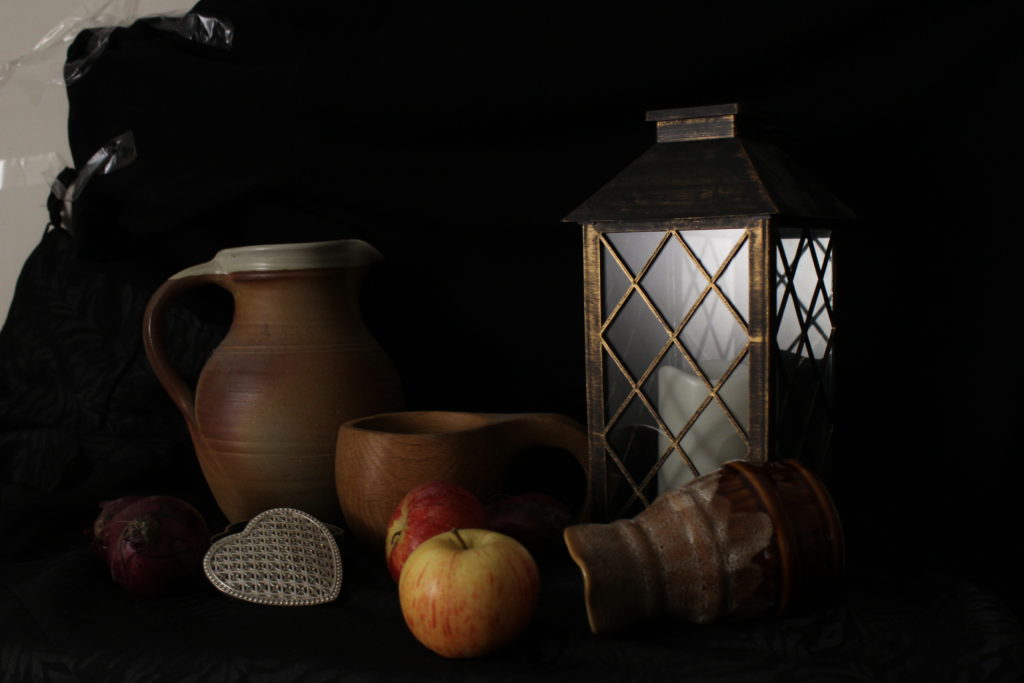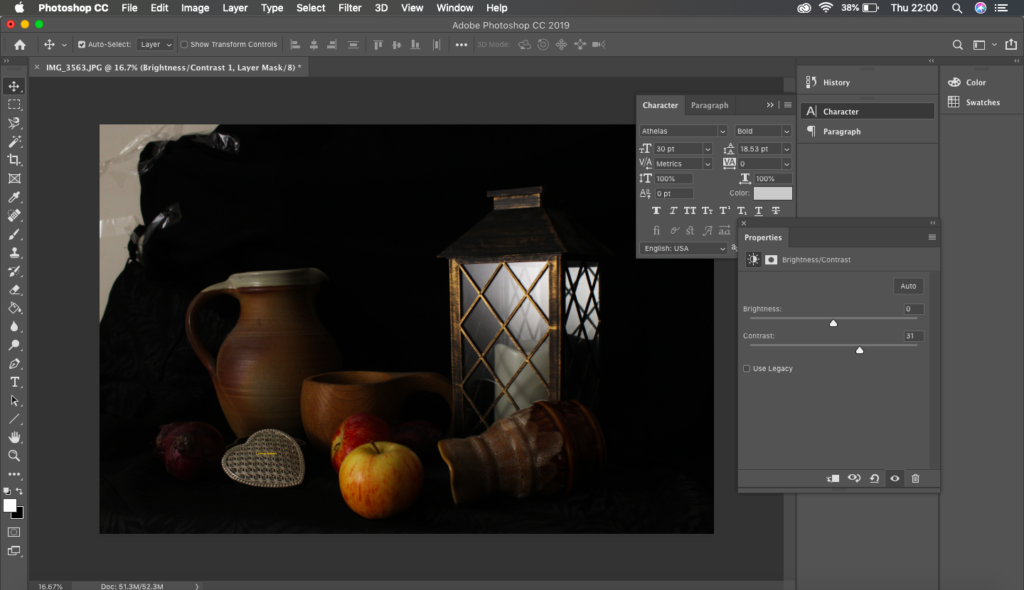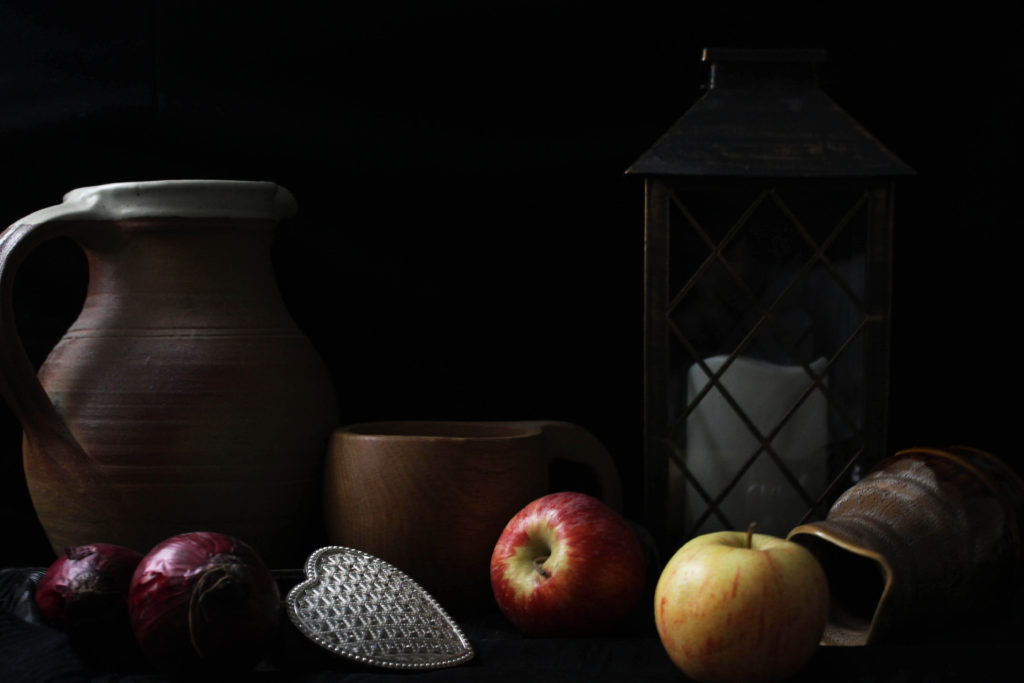PHOTOSHOOT PLANNING:
HOW: In order to do this photo shoot, a little bit of planning and preparation had to go into it beforehand as the correct setup was essential in order to create the images. I used a one point lighting system and black fabric in order to create the base for the items.
WHERE: I stationed the items on top of a fairly tall table as I found it would be much more beneficial if the items were at eye level as most still life imagery is captured from this level.
WHY: In order to explore history and a variety of visual arts, still life was an interesting topic to research and find out about as it is a very classical art form which spans hundreds of years into the past.
WHAT: In order to create the images I used items which would fit the theme of still life best, using pottery, vegetables, and silverware. Although there is a clear lack of variety, I used what I had at the time to create these images.
WHEN: I took these images at night as it was crucial to create chiaroscuro lighting within the images, this could only be done if there was one light source and a completely dark background.
EDITING:
For most of the images the best approach to editing the images was to do a couple simple adjustments. Firstly, in order to make them professional and neat I decided to crop them a fair amount as during the set up process, the black fabric which I used was not wide enough to cover the entirety of the screen, leaving white edges which disturbed away from the actual still life. I also adjusted the tilt shift on the images as it was crucial that the still life is situated on a horizontal surface. I then drastically increased the contrast of the images as one of the key elements of still life is the drastic change from highlights to shadows therefore it was necessary to bring this down. I lastly also increased the saturation of the images as I was keen to make the yellow and red apples in the image a focal point.



This image is a good example of how a simple increase in contrast, saturation and cropping can make an image look a lot more professional and much more believable that this is an actual still life set up.
SUCCESSFUL IMAGES:

MOST SUCCESSFUL IMAGE:
IMAGE ANALYSIS:
VISUAL:
In terms of the visual aspects of the image, it is extremely impactful in various aspects. Firstly the contrast between the backdrop and the highlights is very intense. I used chiaroscuro lighting in order to achieve this effect by only using one light source, this created a very effective recreation of traditional still life imagery. The deep and dark black backdrop is very indicative of the style as the majority of still life imagery displays this as well. One of the focal -points of the image is the apples which are centered in the bottom half of the image, the bright red and yellow makes them extremely noticeable among the muted color scheme of the other objects. There is no set arrangement with the other objects and they appear to be just left as they have been there, used and left. There is no real sense of depth within the image as the black background merges the layers of the image together almost into one.
TECHNICAL:
In terms of the technical set up of the still life, I had to put in a bit of thought into how and where to do it at the time. Firstly it was essential that I did this during night time as I needed a dark surrounding in order to create the chiaroscuro lighting which can be seen in the image above. I also had to set up a one point light system which in order to create the chiaroscuro lighting, it also gave it the authentic still life feel which I was going for. In terms of the camera setting, I used the manual setting on my camera as it was a fairly dark environment and needed ti increase the exposure to a certain level in order to avoid an under exposed image. I needed to also increase the aperture to let in as much light as possible into the camera. The most important part of this photo shoot was definitely the composition of the items within the still life. The arrangement and items which I chose, very much fit the still life concept in terms of being historically appropriate.
CONCEPTUAL:
When creating this still life imagery, the main concept which I was trying to convey was the period specific features of still life, recreating them with photography instead of other artistic mediums. All of the composition rules come into play here; that’s why still life shots are so valuable as a learning tool. You have the rule of thirds, leading lines, diagonals, geometric shapes, and visual weight (determined by either the object’s size or color). Every subject of every still life photo has some sort of appealing feature. It might be the shape, or possibly its color. Sometimes it is the object’s function, its texture and so forth. There is something interesting.
CONTEXTUAL:
Still life photography is a genre of photography used for the depiction of inanimate subject matter, typically a small group of objects. It is the application of photography to the still life artistic style. An example is food photography.This genre gives the photographer more leeway in the arrangement of design elements within a composition compared to other photographic genres, such as landscape or portrait photography. Lighting and framing are important aspects of still life photography composition.Popular still life images include groups of flowers, food, and desk space, but still life photography is not limited to those 3 categories. Typically, still life’s are not close up to the subject nor far away, but at a very medium angle. The art in still life photography is often in the choice of objects that are being arranged and the lighting rather than the skill of the photographer.


